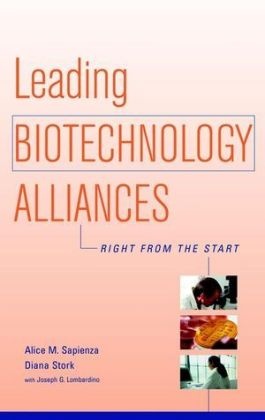Read more
Informationen zum Autor ALICE M. SAPIENZA , DBA, is Professor of Health Care Administration in the Graduate School for Health Studies at Simmons College in Boston, Massachusetts. DIANA STORK , PhD, is Associate Professor at the Graduate School of Management at Simmons College. JOSEPH G. LOMBARDINO , PhD, is retired from the pharmaceutical R&D division of Pfizer, Inc. Klappentext Since the early 1990s, research and discovery collaborations between biotechnology and pharmaceutical companies have increased to the point that they now provide more than half of the total capital invested in the biotechnology sector. Although smaller biotechnology companies may be engaged in only a few alliances at a time, some of the most active pharmaceutical players may be engaged in anywhere from thirty to forty alliances at once. Any single alliance relationship may be the lifeblood for a small biotechnology company, while the same relationship may be just one of many for the pharmaceutical partner. Research alliances with small, close-to-the-science companies are the source of many of the innovative ideas of today and the future, but they present formidable challenges. Successful collaboration depends not only on the solution of scientific and technical problems, but also on the successful resolution of many leadership and organizational problems. Leading Biotechnology Alliances presents a tightly focused discussion regarding issues and questions that are unique and critical to the effectiveness of alliances, including: * Power differences and other asymmetries between partner firms and some implications for alliance dynamics * Sector history and evolution as a basis for understanding the cultural divide that characterizes many biotechnology-pharmaceutical relationships * Why leaders on the biotechnology side must assume the greater leadership responsibility in these alliances * Different--and predictable--challenges over the alliance life cycle, from start to completion/termination * Leadership roles needed for productive and effective collaboration across groups, locations, and companies From societal and economic perspectives, it is important to lead biotechnology alliances right, right from the start. The intent of Leading Biotechnology Alliances is to help scientists and executives from large and small companies do just that--collaborate productively and effectively. This book includes a case study, numerous interview excerpts, general theory and background, a delineation of alliance responsibilities, and a set of alliance effectiveness questions. Together, these ingredients provide the reader with a clear understanding of the complicated dynamics of alliances and leadership issues and roles within the alliance life cycle. Zusammenfassung Fast alle Pharmazie- und Biotechnologieunternehmen bilden strategische Allianzen, die eine gewaltige Herausforderung für das Management bedeuten. "Leading Biotechnology Alliances" vermittelt sofort anwendbare Methoden und Verfahren für den Umgang mit zwischenmenschlichen Beziehungen im Rahmen dieser strategischen Allianzen. Durch die hier vorgestellten "4 Is" der Intergration (Innovation und Kreativität, Ideologie und Kultur, Interdependenz und Konfiguration sowie Individuen und Karriere) schaffen die Autoren einen vorbereiteten Rahmen, der Managern und Wissenschaftlern dabei hilft, die komplexen Fragen im Umgang mit strategischen Allianzen in der täglichen Praxis besser zu verstehen. Enthalten sind Interviews mit einer breiten Palette von Mitarbeitern aus Pharmazie- und Biotechnologieunternehmen. Darüber hinaus behandeln die Autoren auch Fragen, die für Biotechnologie-Allianzen von entscheidender Bedeutung sind. "Leading Biotechnology Alliances" - eine aufschlußreiche Lektüre für Brancheninsider und Investoren gleichermaßen. Inhaltsverzeichnis TROUBLE IN ALLIANCE LAND. A ...

